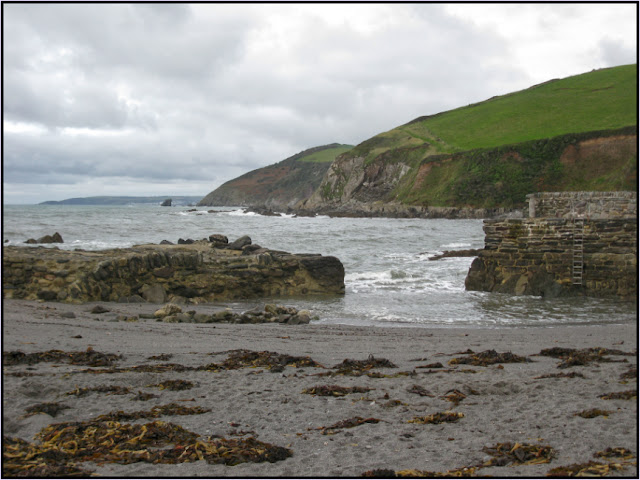Portwrinkle, Finnygook Beach and Eglarooze Cliff
Reposted January 2022 after being lost on Photoblog.
by Gethin Thomas OCTOBER. 09, 2020
First I have to admit I misled you in my last post mentioning the Duke of Portwrinkle. Unfortunately there is no such person, although there should be, and if I am ever ennobled for services to blogging I will choose the title of Lord Portwrinkle.
Portwrinkle is a tiny village in Cornwall, a former fishing village, with what now appears to be a tiny harbour full of sand which actually makes a fantastic, safe, and secluded little beach. The fact we are in Cornwall also explains the other strange names of which there are many in Cornwall. The reason behind this is the fact that Cornwall is an ancient county and has it's own ancient Celtic language which reflects in it's place names, which over time have been anglicised into meaningless soundalike names of former places that were named with a purpose.
Why were we in Portwrinkle? Well we were going to a nearby town to meet friends and as we were making a day trip out of it I had a look to see what else was there. I saw the name Portwrinkle and decided we had to go just for that reason, so I could say I have been to Portwrinkle. Then I saw that the only street in Portwrinkle was called Finnygook Lane. That was the decider. Then I discovered that the nearby cliffs were called Eglarooze, so that was it, who wouldn't go to Portwrinkle?
Grade 2 listed Smugglers Cottage, as of writing it is for sale. I'm guessing that if it was ever occupied by smugglers in the past they didn't have a plaque on the front advertising that fact.
The Offences against Customs or Excise Act of 1745 was a statute in English law, specifying severe punishment for smugglers and their helpers under certain conditions, with financial inducements to bring them to justice.
The Statute of 1745 is considered the leading statute for smuggling law in 18th-century England as it makes the greatest effort to convict offenders and to sentence those convicted to death. This statute, part of the Bloody Code, further extended the means by which a person could be convicted for smuggling and put to death without benefit of clergy. As the smuggling war continued to burden Parliament in 18th-century England, it became even more crucial to find ways to convict criminals. There were other measures outside death such as the lesser penalty of transportation. This option was available for the lesser crimes, and comparatively few smugglers were actually convicted and even fewer sentenced to death.
Even so I am willing to bet that it is far more likely that quaint little cottages were more likely called "Definitely Not Smugglers Cottage and In Case you're asking I have got an alibi".
I have a theory on how Portwrinkle got it's name. When I was still at school and college we used to go on trips to London, and I always used my trusty AtoZ to get around. The Ato Z is an institution in itself and is a book of maps of every street in London. It was first designed by Phyllis Isobella Pearsall MBE. If they had ennobled her instead of giving her a mere MBE she could have been the Baroness Portwrinkle.
Using an AtoZ though, gains you one bad habit. As you get to know a place it is a disjointed one, made up of separate book pages all in a jumble in your head and it never seems to join together into a bigger place that makes sense. So I knew London well but only in pairs of pages that were next to each other. When you come to the edge of the page you don't necessarily walk over the edge onto the next page you might often have to leap across the book by maybe ten pages. This has consequences.
It is easy to think you have to get the Underground/Tube to where you want to go because it is ten pages away when in reality it may be just around the corner of the building right in front of you.
I call this the law of maps, where everywhere you are trying to get to is always tucked away in the crease in the middle or just drops off the edge of the page. So after all that waffle, here is my theory about Portwrinkle and you may now have got there ahead of me.
The many ships and sailors who travelled along the Cornish coast just West of Plymouth could see from their boats that there was a little harbour there but it fell into the crease of the map so none of them could read it's real name so that port in the wrinkle of the unfolded map became known as Portwrinkle.
Although you couldn't get a fishing boat into harbour now because it has a beach instead, there is proof of earlier activity in this winding gear which was used for hauling up the boats.
The Geology of Cornwall is distinct from the rest of Britain and one of the features are these quartz veined rocks.
Just to one side in the harbour is an old weathered cabinet on which someone had placed found items left behind. I wonder how long someone was looking for their keys and I also wonder how you get a toddler home without noticing they are barefoot?
Built in the mid-nineteenth century, Tregantle Fort was the lynch-pin of the Western Lines - a series of fortifications that were part of a wider scheme to defend Plymouth Sound. Although mothballed in the inter-war years, the site has remained in military ownership and is still used as a training establishment for all three Armed Services.
Tregantle Fort was built between 1858 and 1865 as part of a major fortification programme initiated as a result of French re-armament. By this time Britain had become the dominant sea power and maintained that position by ensuring the Royal Navy was larger than the combined might of the next two biggest navies.
Africa comes to Cornwall. These are Red Hot Pokers native plants of Africa here looking splendid and majestic.
Kniphofia also called tritoma, red hot poker, torch lily, or poker plant, is a genus of perennial flowering plants in the family Asphodelaceae, first described as a genus in 1794. The genus Kniphofia is named after Johann Hieronymus Kniphof, an 18th-century German physician and botanist.
He studied medicine at the Universities of Jena and Erfurt, becoming a professor of medicine at the latter institution in 1737. In 1745 he succeeded Andreas Elias Büchner (1701–1769) as director of the library at Erfurt. At Erfurt, he assembled a large and impressive herbarium, about which in 1733, he first published a work with the title of "Botanica in originali". Considered to be Kniphof's magnum opus, it would eventually be published in several editions. It was renowned for employing a preparation/printing technique known as "nature printing", which at the time was a little understood process that Kniphof had mastered in order to imprint details of various botanical specimens. The botanical genus Kniphofia (family Asphodelaceae) was named in his honor by botanist Conrad Moench. (wikipedia)
This steep little lane caught my eye, although I didn't spot the small almost ground level post box until I looked at the photo later. I don't think I have ever seen a ground level post box before. The double yellow lines bouncing around it make doubly sure you don't park in front of it.


























Sorry if this is a double post - came up at first with no account. In any case, loved the crusty, rusty metal shots best of all. May you someday realize your dream of becoming Lord Portwrinkle.
ReplyDeleteThank you lowly serf. 🤣🤣
ReplyDelete